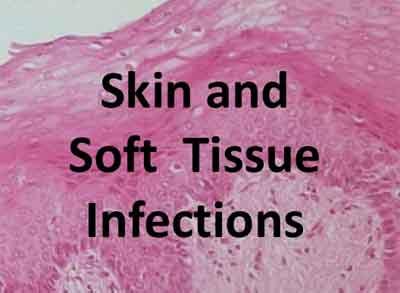- Home
- Editorial
- News
- Practice Guidelines
- Anesthesiology Guidelines
- Cancer Guidelines
- Cardiac Sciences Guidelines
- Critical Care Guidelines
- Dentistry Guidelines
- Dermatology Guidelines
- Diabetes and Endo Guidelines
- Diagnostics Guidelines
- ENT Guidelines
- Featured Practice Guidelines
- Gastroenterology Guidelines
- Geriatrics Guidelines
- Medicine Guidelines
- Nephrology Guidelines
- Neurosciences Guidelines
- Obs and Gynae Guidelines
- Ophthalmology Guidelines
- Orthopaedics Guidelines
- Paediatrics Guidelines
- Psychiatry Guidelines
- Pulmonology Guidelines
- Radiology Guidelines
- Surgery Guidelines
- Urology Guidelines
AIIMS guidance on antibiotic use in Skin and soft tissue infections

Main recommendations:
1.) Impetigo: Impetigo is a superficial infection of the skin. Starts with small vesicles that turn into pustules and ruptures readily. The purulent discharge dries and forms the characteristic golden yellow crusts. Pruritus is common and scratching of lesions results in spreading of infection. Healing generally occurs without scarring.
2.) Ecthyma: It is an ulcerative form of impetigo with punched out edges.
Treatment:
A) Impetigo with numerous lesions, ecthyma or to control transmission during outbreaks, Bullous impetigo)- Staphylococcus aureus:
Preferred: Amoxicillin-clavulanate 625mg TDS
Alternative: Cephalexin 250-500 QID or Cefuroxime 250-500 mg BD
If suspicion of MRSA:
Preferred: Linezolid 600mg BD
Alternative: Cotrimoxazole DS BD
B) Non-bullous impetigo- fewer lesions- Group A Streptococcus (GAS)
Preferred: Topical Mupirocin BD
Alternative: Topical Fusidic acid QID
Special Remarks:
-Blood culture is not essential
-Duration: 5-7 days
3.) Erysipelas: This is a superficial infection of the skin, with prominent lymphatic involvement. It is a painful lesion with bright red, oedematous and indurated appearance. It has sharply demarcated borders. Presence of fever is a usual finding.
Treatment:
No systemic signs of toxicity- GAS:
Preferred: Amoxicillin-clavulanate 625mg TDS for 5-7 days
Alternative: Cephalexin 250-500 QID or Cefuroxime 250-500 mg BD for 5-7 days
With signs of systemic toxicity/Rapid progression of symptoms despite 48 hours of oral- GAS:
Preferred: Injection Ceftriaxone 1-2 g IV BD for 5 to 14 days
Alternative: Clindamycin 600mg TDS for 5 to 14 days
4.) Cellulitis: Acute spreading infection that involves subcutaneous tissue. Clinically rapidly intensifying pain and redness is a common presentation. Fever and lymphadenopathy may be present. The borders in cellulitis are not well demarcated.
Treatment:
Without signs of systemic toxicity- Staphylococcus aureus:
-Tab Amoxicillin – clavulanate (625 mg) 1 tab TDS for 5 days
-If MRSA suspected- Cotrimoxazole DS BD or Linezolid 600 mg BD
With signs of systemic toxicity/Rapid progression of symptoms despite 48 hours of oral/proximity of the lesion to an indwelling medical device- Staphylococcus aureus:
-Vancomycin (1g IV BD) or Teicoplanin (400 mg IV 12th hourly for three doses followed by 24th hourly) or Linezolid (600 mg BD) or Daptomycin (6 mg/kg OD) for 5-14 days
5.) Necrotic soft tissue infection: Erythema/oedema/
Necrotising fasciitis: Rapidly spreading infection located in the fascial planes of connective tissue that results in tissue necrosis. It can affect any part of the body but is most common in the lower limb. Abdominal wall, perianal/ groin areas and postoperative wounds are the other areas that are usually affected. The affected area is erythematous, swollen without sharp margins, hot, and painful in the early stage. Within3 to 5 days after onset, skin starts breaking down developing into bullae and subsequently cutaneous gangrene.
Gas gangrene: It is a rapidly progressive life-threatening myonecrosis. It presents as a foul-smelling serosanguinous discharge from the wound. Crepitus is usually present. The area later turns into greenish-black cutaneous necrosis. Gram stain usually shows gram-positive bacilli with/ without spores. Anaerobic culture turns positive in as early as 6 hours’ time, with the growth as fast as the clinical progress. Imaging of the area may show evidence of gas in muscles and fascial planes.
Treatment:
Carbapenem (Imipenem 500 mg QID/Meropenem 1g TDS)/ BL-BLI inhibitor (Piperacillin-tazobactam 4.5 g QID/Cefoperazone sulbactam 3g BD)
Plus, MRSA coverage (Vancomycin/ Teicoplanin/ Linezolid) Plus Clindamycin (600-900 mg IV TDS)- anti-toxin activity
Urgent surgical debridement

Disclaimer: This site is primarily intended for healthcare professionals. Any content/information on this website does not replace the advice of medical and/or health professionals and should not be construed as medical/diagnostic advice/endorsement or prescription. Use of this site is subject to our terms of use, privacy policy, advertisement policy. © 2020 Minerva Medical Treatment Pvt Ltd